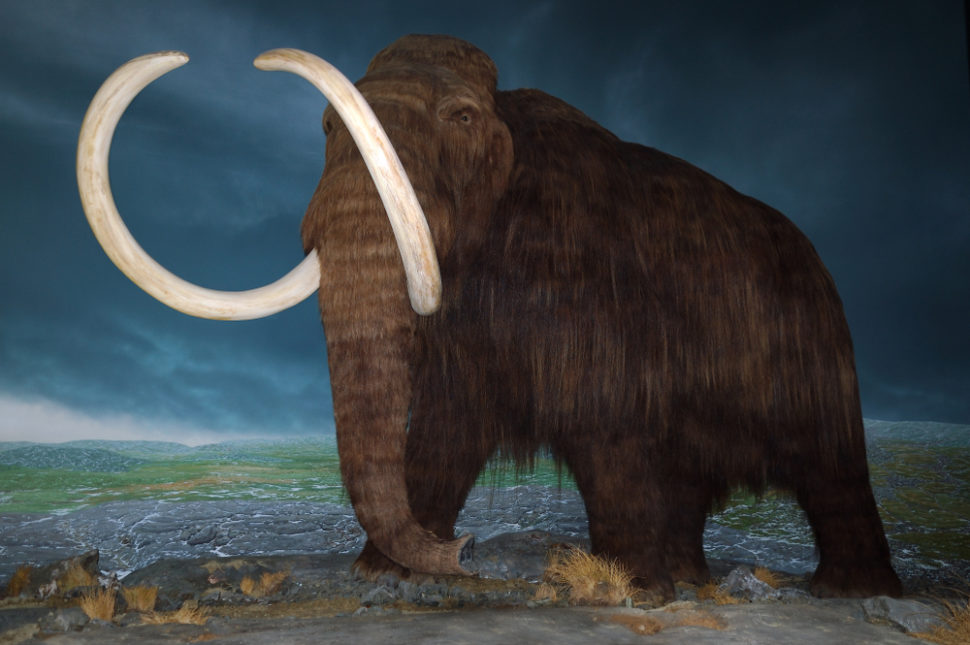If today’s polar bears are the symbol image of global warming, mammoths are the iconic species that define the last Ice Age.
A herd of stampeding mammoths must have been a sight to behold for prehistoric humans.
After roaming the face of Earth for hundreds of thousand years, mammoths died out about 4,000 years ago, when Earth’s climate was getting warmer. But it isn’t clear how climate change contributed to mammoths extinction.
Woolly mammoths coexisted with prehistoric humans who without doubt hunted them for their tusks, fur, and bones. Again, whether this was the main driver of the species demise remains unclear.
Perhaps it’s a combination of the two factors, nature and humans. As the planet warmed, ice melted, leading to dense forests replacing grasslands, mammoths natural habitat. Then, human large game hunters might have killed off the last surviving mammoths.
Thanks to advancing biotechnology and genome sequencing, biologists now think that reviving woolly mammoths isn’t only possible, but also recommendable. Reintroducing mammoths into nature, among other extinct species, could help the planet heal some of its climate change scars.
Bringing Back Mammoths One Cell at a Time
Akira Iritani is a Japanese biologist who produced hundreds of books and research papers on animal reproduction with a number of in-vitro breakthroughs along the way.
But 90-year-old Dr. Iritani has had one dream: resurrecting mammoths. Iritani was about to lose hope on making it happen until the discovery of “Yuka”.
In 2012, Russian villagers discovered a well-preserved carcass of a female woolly mammoth baby, dubbed “Yuka“, that has been buried deep in the Siberian permafrost for the last 28,000 years.
“I’d been trying to find dormant mammoth cells for 20 years but as I’m (now) 90, I thought I should just give up and accept death,” Dr Iritani told CNN. “I’m so happy with this latest research. It feels like Yuka was waiting for me to find her.”
Leading a research team of Japanese and Russian scientists, Dr. Iritani has made a new step toward bringing woolly mammoths back to life.
They extracted dozens of the less-damaged nucleus-like structures from Yuka’s tissue and, using a technique known as nuclear transfer, implanted them into mouse oocytes that facilitate the development of embryos.
Authors of the paper reported that:
“In the reconstructed oocytes, the mammoth nuclei showed the spindle assembly, histone incorporation and partial nuclear formation; however, the full activation of nuclei for cleavage was not confirmed,”
Iritani also noted that he:
“Was looking under the microscope at night while I was alone in the laboratory. I was so moved when I saw the cells stir. I’d been hoping for this for 20 years.”
Observing traces of cell activity in long-dormant woolly mammoths under a microscope is a milestone. D.r Iritani and his team’s work doesn’t mean we’ll be seeing grazing woolly mammoths anytime soon. However, it does show that perhaps all biologists need to de-extinct animals is better DNA samples and better cloning tech.
Read More: AI Reveals Existence of a Third Unknown Human Ancestor
You probably know the fictional Jurassic Park from the movies where scientists at the service of corporate interests cloned dinosaurs.
Unlike dinos, mammoths aren’t as scary in the collective imagination. And unlike Jurassic Park, the Pleistocene Park is a real place.
The Pleistocene Park is a nature reserve in Siberia where scientists have been trying to recreate the grassland ecosystems of the late Pleistocene epoch, or the Ice Age. So, if mammoths ever came to life again, they have a place to call it home.


















Amazing! Is it true that animals in Pleistocene Park have no fear of man?
A heartfelt story.